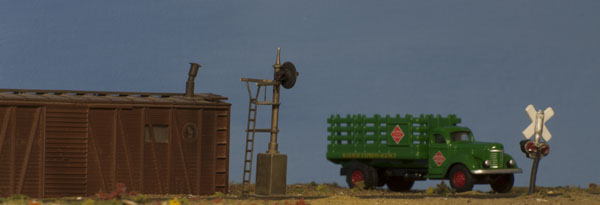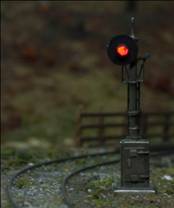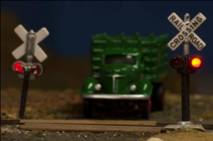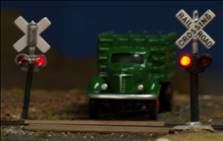LEDs
What we can do with LEDs?
by Paul Wussow

What we can do with LEDs?
by Paul Wussow
This clinic was planned to have a hands on building of flashing crossbucks, but we ran into a few problems. The materials have been on back order for about a month at the Choo Choo Store. While Dale has been working hard to get us the plastic sets of gates and crossbucks all his suppliers have been giving him backorder status. Also we were not be able to solder at the Rhinelander library for fear of setting off the fire alarms. I presented an introduction to LEDs at the meeting and have included this handout that was in this newsletter.
At the Library I took the first hour to share with the group the differences between Led and incandescent lighting as they related to model railroading. This was not a slide show but a chance to pass around a few models that I built that demonstrated the use of different types of LED and incandescent lamps. Single head signals producing tri colors with bi-color LEDs two lamp signals using 2 and 3 wire circuits to show red or green signals and more. There were 3 lamp signals with Red Yellow and Green LEDs using common anode circuits. Most everything was handed around and questions about the use and “how do they do that?” were answered.
Let’s explore what we can do with LEDs on our layout. 
Signals and Crossing:
In this photo we see a single searchlight signal and a flashing crossbuck. Each is connected to a different circuit; the signal uses a 2 wire bi-color LED. When the polarity of the wires is flipped the color changes from red to green. If an oscillator is used to rapidly flip the polarity the signal will show yellow. Simple connections to a SPDT switch connected to a turnout motor and a bi-polar power supply the signal will show red or green on the approaches to the depending on the position of the turnout.



An Introduction to LED for
Model Railroaders
These come in most of our locomotives as headlights and marker lights.
Many are 12 to 14 volt lamps connected to the track power AC or DC.
These will get brighter as you add power and the train runs faster.
In newer units you may find a diode board that lights the lamps as you start and keeps them at the same level of illumination. Caution these lamps are 1.5 volt and will burn out if connected to track power or a DCC decoder.
Direct connections to a decoder should be done with a 14 volt lamp.
These lamps give off heat and will melt plastic if they are on for a long period of time.
Incandescent lamps burn with a warm glow and are redder as the voltage drops.
These lamps draw considerable current which is dissipated as light and heat.
LEDs are low current semiconductors which conduct current in one direction.
When the current flows across the diode junction they emit light. Because they are low current they do not heat up and will not melt plastic.
LEDs are low current devices (.030 to .060 Watts) and require a resistor to limit the current. Failure to limit the current will cause the diode junction to fail thus requiring replacement.
LEDS come in many colors and sizes
Some locomotives come with LED lights wired to boards with resistors built on to the boards.
LEDs may be used with DCC as long as they are wired correctly and have a series resistor.
Bi Color LEDs are 2 LEDs in one case wired opposite each other. When current flows in one direction you see red light and when the polarity is reversed you see green. By rapidly flipping polarity you may produce yellow light.
Most of the commercial Signals are common Anode (+) and the Cathodes (-) are used to control the lighting of any of the LEDs by grounding their lead.